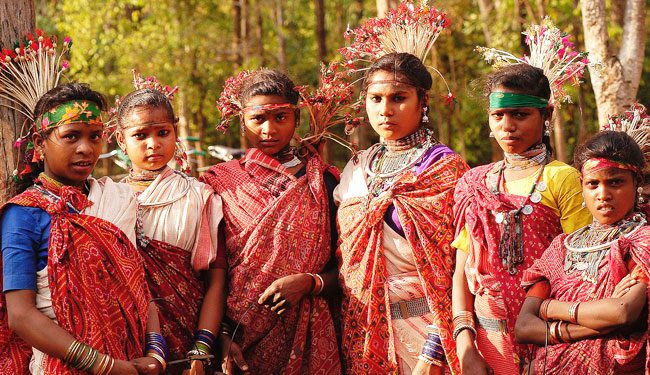Chattisgarh, known as Dhan ka Katora (Pot of Rice), is synonymous with natural beauty and cultural richness. Chattisgarh wedding fashion includes sarees for the women and dhoti for the men. Chattisgarh is the cultural potpourri of central India. In fact, one-third of the Chattisgarh population comprises of tribal communities, the major ones being the Gond, Brinjhwar, Kanwar, Bhaina, Oraon, Bhatra, Halba, Kamar, Baiga, Kowa, Bharia, Sanwra, Kharia, Manghar, and Dhanwar.
Weddings in Chattisgarh generally take place in the months of March, April, and June, and are conducted amid elaborate rituals, customs and community celebrations. Men and women dress up in a variety of tribal costumes that lend a vibrant atmosphere to festivities. The typical costume for men from tribal communities like the Ghotuls, Marias, Halbas, Abhuj, and Murias is a dhoti and headgear in the form of a turban. Women wear knee-length or full-length saris in bright colors. It is not uncommon to find people sporting bright headgear’s, peacock feathers, and chunky ornaments made from wood or metal.
As one moves outwards into the more urban areas of the state, wedding attires imbibe cultural influences from neighboring states. Women wear a wide range of sari materials, ranging from the ethnic Batik sari to Chanderi silk, Orissa silk and Maheshwari silk.
Tribal men and women adorn a wide set of ornaments for weddings and festivals. Decorative items used by women include the Baanda (necklace made of coins), a silver necklace called the Suta, a Phuli for nose, Bali and Khunti for ears, Ainthi (silver worn on forearm), Kardhini (a siver belt for the waist), a ring for the upper arm or the Pounchhi, Bicchiya for toes, and Patta or Choora bangles. Men generally wear Koundhi, which is a necklace made out of beads, and a bangle known as Kadhah during dances.
Cowries, beads, shells, feathers, and bones, are other materials that the tribal communities like to ornament themselves with.
In earlier times, women decorated themselves with garlands made from ‘one rupee’ coins. This trend is, however, now on the decline.
A unique custom of Gond tribes is that the groom pays a suitable ‘bridal price’ to the father of the bride, showing his respect to the family.
Agencies






































